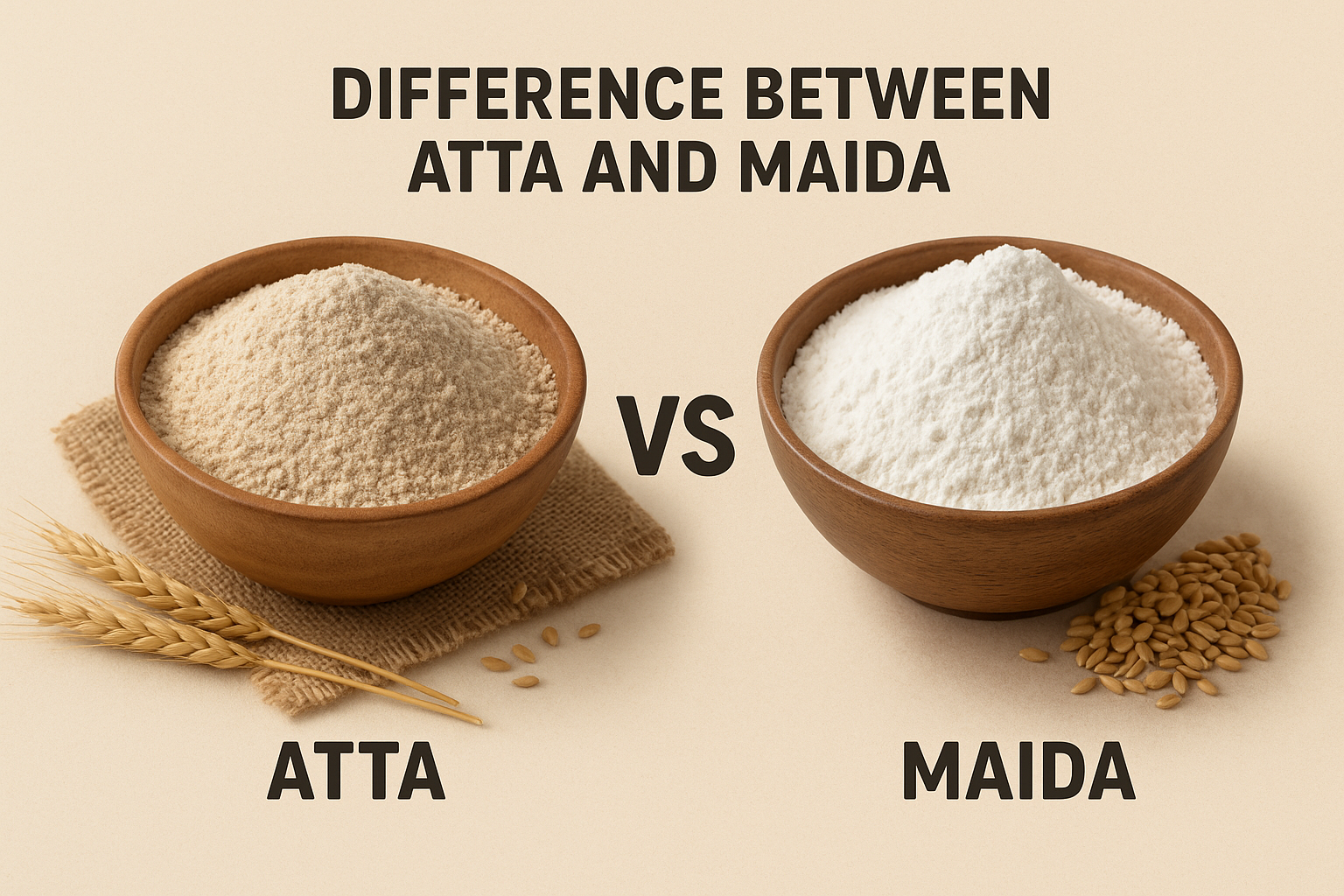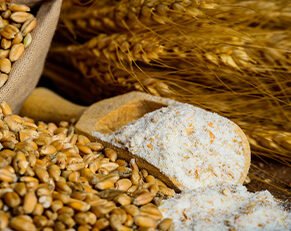Top 5 Facts You Must Know About the Difference Between Atta and Maida
Introduction
In every Indian kitchen, atta and maida are two of the most commonly used flours. From the soft rotis served at home to the fluffy cakes at bakeries, these wheat-based flours form the foundation of countless dishes. However, while they may appear similar at first glance, their origin, processing, nutrition, and impact on health are drastically different.
Understanding the difference between atta and maida is crucial — not just for cooking perfection, but also for maintaining good health. In this article, we’ll uncover the top 5 essential facts that highlight how these flours differ, their nutritional impact, and how you can make smarter choices in your kitchen.
Source and Processing Method
Both atta and maida are derived from wheat grains, but the way they are processed determines their distinct characteristics.
How Atta is Made
Atta, or whole wheat flour, is produced by grinding whole wheat grains, which include all three parts of the kernel — bran, germ, and endosperm. This traditional method preserves all natural nutrients, making atta rich in fiber, vitamins, and minerals. The bran gives atta its coarse texture and slightly brownish color.
How Maida is Made
Maida, on the other hand, undergoes an intense refining process. Only the endosperm of the wheat grain is used, while the bran and germ — the most nutritious parts — are removed. The flour is then bleached to achieve its pure white, smooth texture. This refinement results in a product that’s visually appealing but significantly lower in nutritional value.
Impact of Processing
The refining process of maida strips away essential nutrients like iron, magnesium, and B vitamins, while also removing dietary fiber. Atta’s whole-grain structure helps retain nutrients and supports better digestion. Therefore, while both flours share the same source, their processing creates a vast nutritional gap.
Nutritional Difference
The nutritional value of atta vs maida is one of the most significant factors to consider. Below is a clear comparison of their key nutrients per 100 grams:
| Nutrient | Atta (Whole Wheat Flour) | Maida (Refined Wheat Flour) |
|---|---|---|
| Fiber | 10-12g | 2-3g |
| Protein | 11-13g | 8-9g |
| Iron | High | Low |
| Vitamins (B-complex) | Retained | Lost during processing |
| Carbohydrates | Complex carbs | Simple carbs |
| Calories | ~340 kcal | ~365 kcal |
Key Insights
- Atta is a whole grain that provides complex carbohydrates, keeping you fuller for longer.
- Maida offers empty calories, as it lacks fiber and essential nutrients.
- The high fiber in atta helps regulate digestion and prevent constipation, while maida’s low fiber can cause digestive issues when consumed frequently.
Simply put, atta nourishes, while maida primarily provides energy without much nutrition.
Impact on Health
The choice between atta and maida goes far beyond taste or texture — it directly affects your health and wellbeing.
Atta: A Health-Friendly Flour
Because atta is a whole grain, it digests slowly, leading to a steady release of energy. This helps maintain stable blood sugar levels and prevents sudden spikes in glucose. The dietary fiber also supports gut health, improves digestion, and aids in weight management.
Regular consumption of whole wheat atta is linked to a lower risk of type 2 diabetes, heart disease, and obesity. It also provides a consistent source of vitamins B1, B3, and folate, essential for energy metabolism and brain function.
Maida: The Less Healthy Choice
Maida, however, is quickly absorbed by the body due to its high glycemic index. This causes rapid spikes in blood sugar, leading to energy crashes and cravings. Long-term consumption of maida-based foods like white bread, noodles, and pastries is associated with insulin resistance, weight gain, and digestive issues.
Moreover, bleached maida may contain chemical residues used during the whitening process, making it less desirable for regular consumption.
If you’re aiming for a healthy lifestyle, reducing maida intake and opting for atta or multigrain alternatives is a wise decision.
Texture and Culinary Uses
The texture and culinary uses of atta and maida vary significantly, influencing the outcome of your recipes.
Atta: Coarse, Elastic, and Nutty
Atta has a coarse texture and a natural elasticity that makes it perfect for traditional Indian dishes. The bran content gives it a slightly earthy flavor and helps create soft, chewy rotis, chapatis, parathas, and puris. The gluten in atta also allows dough to hold together well, giving a satisfying texture to flatbreads.
Maida: Smooth, Fine, and Versatile
Maida’s fine, refined texture makes it the flour of choice for baking and confectionery. It’s used extensively in cakes, pastries, bread, samosas, momos, and noodles. Its ability to form soft, airy dough gives baked goods their signature lightness.
Tips for Usage
- Use atta when you want wholesome, fiber-rich meals.
- Use maida for recipes requiring fine texture or softness.
- For a balanced approach, try mixing atta and maida in a 70:30 ratio — ideal for softer rotis or baked items with added nutrition.
Healthier Alternatives and Mixing Tips
As consumers become more health-conscious, there’s a growing demand for unrefined and fortified flours that balance taste with nutrition.
Healthier Alternatives
- Multigrain Atta – A blend of wheat, barley, millet, and oats offering more fiber and protein.
- Whole Wheat Flour – The closest substitute for atta, packed with nutrients and minimal processing.
- Fortified Maida – Some brands enrich maida with iron and vitamins to restore some lost nutrients.
- Gluten-Free Flours – For those with gluten intolerance, flours like ragi, jowar, or bajra can be excellent substitutes.
Mixing Tips for Better Health
- Mix 75% atta + 25% maida for softer rotis with better taste.
- Add soy flour or oats flour to atta for a protein and fiber boost.
- For baking, substitute half the maida with whole wheat flour to make muffins or cakes healthier without sacrificing texture.
These small adjustments can make a huge difference in maintaining your daily nutrition.
Conclusion
To summarize, while atta and maida come from the same wheat source, their processing, nutritional content, and health effects set them miles apart. Atta retains its natural nutrients and fiber, supporting digestive and metabolic health. Maida, though perfect for bakery-style foods, lacks essential nutrients and may contribute to long-term health issues if consumed excessively.
Choosing atta or healthier flour alternatives can greatly benefit your well-being without compromising on taste. Remember — the best flour is the one that nourishes your body as much as it delights your palate.


